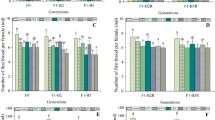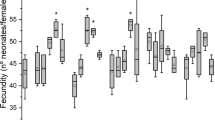Abstract
The effects of emerging contaminants on environmental health are of high concern, especially those potentially induced by mixtures. We assessed single and composite mixtures of triclosan (T), 17β-estradiol (E2), sulfamethoxazole (SMX), and nicotine (N) at various concentrations, on neonates of Daphnia magna. When used in single exposure, T and N induced high toxicity (100% immobility, each one), compared to SMX and E2 (2.5% and 10% immobility, respectively). When T, E2, SMX and N were in mixture, T had the highest contribution to the overall toxicity in mixture exposures. The N toxicity lowered when in a fourfold exposure (85% immobility in fourfold exposure). Due to the high toxicity of T and N, both alone and in the mixtures, our results can serve as a warning about the use of these substances and their release in the aquatic ecosystem.

Similar content being viewed by others
References
Andersen HR, Halling-Sørensen B, Kusk KO (1999) A parameter for detecting estrogenic exposure in the copepod Acartia tonsa. Ecotoxicol Environ Saf 44(1):56–61
Anh HQ, Le TPQ, Da Le N, Lu XX, Duong TT, Garnier J et al (2020) Antibiotics in surface water of East and Southeast Asian countries: a focused review on contamination status, pollution sources, potential risks, and future perspectives. Sci Total Environ 764:142865
Ao X, Liu W, Sun W, Yang C, Lu Z, Li C (2018) Mechanisms and toxicity evaluation of the degradation of sulfamethoxazole by MPUV/PMS process. Chemosphere 212:365–375
Araujo GS, Pavlaki MD, Soares AMVM, Abessa DMS, Loureiro S (2019) Bioaccumulation and morphological traits in a multi-generation test with two Daphnia species exposed to lead. Chemosphere 219:636–644
Arnold KE et al (2013) Assessing the exposure risk and impacts of pharmaceuticals in the environment on individuals and ecosystems. Biol Lett. https://doi.org/10.1098/rsbl.2013.0492
Barata C, Baird DJ, Nogueira AJA, Soares AMVM, Riva MC (2006) Toxicity of binary mixtures of metals and pyrethroid insecticides to Daphnia magna Straus. Implications for multi-substance risks assessment. Aquat Toxicol 78(1):1–14
Bellot M, Barata C, Gómez-Canela C (2021a) Aqueous stability and degradation of psychiatric and neuroactive compounds and its biological activity in Daphnia magna. Sci Total Environ 798:149252
Benowitz NL, Hukkanen J, Jacob P (2009) Nicotine chemistry, metabolism, kinetics and biomarkers. Nicot Psychopharmacol. https://doi.org/10.1007/978-3-540-69248-5_2
Boxall AB, Rudd MA, Brooks BW, Caldwell DJ, Choi K, Hickmann S et al (2012) Pharmaceuticals and personal care products in the environment: what are the big questions? Environ Health Perspect 120(9):1221–1229
Brennan SJ, Brougham CA, Roche JJ, Fogarty AM (2006) Multi-generational effects of four selected environmental oestrogens on Daphnia magna. Chemosphere 64:49–55. https://doi.org/10.1016/j.chemosphere.2005.11.046
Brodin T, Fick J, Jonsson M, Klaminder J (2013) Dilute concentrations of a psychiatric drug alter behavior of fish from natural populations. Science 339(6121):814–815
Canesi L, Ciacci C, Lorusso LC et al (2007) Effects of triclosan on Mytilus galloprovincialis hemocyte function and digestive gland enzyme activities: possible modes of action on non target organisms. Comp Biochem Physiol C 145:464–472. https://doi.org/10.1016/j.cbpc.2007.02.002
Capparelli MV, Cipriani-Avila I, Jara-Negrete E et al (2021) Emerging contaminants in the northeast Andean Foothills of Amazonia: the case of study of the city of Tena, Napo, Ecuador. Bull Environ Contam Toxicol. https://doi.org/10.1007/s00128-021-03275-8
Chen K-F, Huang S-Y, Chung Y-T et al (2018) Detoxification of nicotine solution using Fe0-based processes: toxicity evaluation by Daphnia magna neonate and embryo assays. Chem Eng J 331:636–643. https://doi.org/10.1016/j.cej.2017.09.029
Coors A, Frische T (2011) Predicting the aquatic toxicity of commercial pesticide mixtures. Environ Sci Eur 23(1):1–18
CSE (2014) CLP-Hazard-Classification-and-Labelling-Guidance-Note-September-2014.pdf. https://www.hse.gov.uk/pesticides/resources/E/CLP-Hazard-Classification-and-Labelling-Guidance-Note-September-2014.pdf
Dalla Bona M, Lizzi F, Borgato A, De Liguoro M (2016) Increasing toxicity of enrofloxacin over four generations of Daphnia magna. Ecotoxicol Environ Saf 132:397–402
Dann AB, Hontela A (2011) Triclosan: environmental exposure, toxicity and mechanisms of action. J Appl Toxicol 31:285–311. https://doi.org/10.1002/jat.1660
De Coen WM, Janssen CR (2003) The missing biomarker link: Relationships between effects on the cellular energy allocation biomarker of toxicant-stressed Daphnia magna and corresponding population characteristics. Environ Toxicol Chem 22(7):1632–1641
ECHA (2021) Short-term toxicity to aquatic invertebrates. https://echa.europa.eu/fi/registration-dossier/-/registered-dossier/12675/6/2/4. Accessed 14 July 2021
EFSA (2013) Guidance on tiered risk assessment for plant protection products for aquatic organisms in edge-of-field surface waters. EFSA J 11(7):3290. https://doi.org/10.2903/j.efsa.2013.3290
Faucon JC, Bureau R, Faisant J, Briens F, Rault S (2001) Prediction of the Daphnia acute toxicity from heterogeneous data. Chemosphere 44(3):407–422
Fu J et al (2020) The toxic effect of triclosan and methyl-triclosan on biological pathways revealed by metabolomics and gene expression in zebrafish embryos. Ecotoxicol Environ Saf 189:110039
Flaherty CM, Dodson SI (2005) Effects of pharmaceuticals on Daphnia survival, growth, and reproduction. Chemosphere 61(2):200–207
Ginebreda A, Muñoz I, de Alda ML, Brix R, López-Doval J, Barceló D (2010) Environmental risk assessment of pharmaceuticals in rivers: relationships between hazard indexes and aquatic macroinvertebrate diversity indexes in the Llobregat River (NE Spain). Environ Int 36(2):153–162
Hirano M, Ishibashi H, Matsumura N, Nagao Y, Watanabe N, Watanabe A et al (2004) Acute toxicity responses of two crustaceans, Americamysis bahia and Daphnia magna, to endocrine disrupters. J Health Sci 50(1):97–100. https://doi.org/10.1248/jhs.50.97
Hoffmann F (2020) Environmental risk assessment: summary sulfamethoxazole. La Roche 7
Hossain MS, Kubec J, Guo W et al (2021) A combination of six psychoactive pharmaceuticals at environmental concentrations alter the locomotory behavior of clonal marbled crayfish. Sci Total Environ 751:141383. https://doi.org/10.1016/j.scitotenv.2020.141383
Jung J, Kim Y, Kim J, Jeong DH, Choi K (2008) Environmental levels of ultraviolet light potentiate the toxicity of sulfonamide antibiotics in Daphnia magna. Ecotoxicology 17(1):37–45
Kim J, Park J, Kim PG, Lee C, Choi K, Choi K (2010) Implication of global environmental changes on chemical toxicity-effect of water temperature, pH, and ultraviolet B irradiation on acute toxicity of several pharmaceuticals in Daphnia magna. Ecotoxicology 19(4):662–669
Lilius H, Hastbacka T, Isommaa B (1995) Short communication: a comparison of the toxicity of 30 reference chemicals to Daphnia magna and Daphnia pulex. Environ Toxicol Chem 14(12):2085–2088
Macedo S, Torres T, Santos MM (2017) Methyl-triclosan and triclosan impact embryonic development of Danio rerio and Paracentrotus lividus. Ecotoxicology 26:482–489. https://doi.org/10.1007/s10646-017-1778-3
Martin JM, Bertram MG, Blanchfield PJ et al (2021) Evidence of the impacts of pharmaceuticals on aquatic animal behaviour: a systematic map protocol. Environ Evid 10:26. https://doi.org/10.1186/s13750-021-00241-z
Moreira RA, de Araujo GS, Silva ARRG, Daam MA, Rocha O, Soares AM, Loureiro S (2020) Effects of abamectin-based and difenoconazole-based formulations and their mixtures in Daphnia magna: a multiple endpoint approach. Ecotoxicology 29(9):1486–1499
OECD (2012) Guideline for the testing of chemicals no 211. Daphnia magna reproduction test. Organization for Economic Cooperation and development, Paris, p 202
Oropesa AL, Floro AM, Palma P (2017) Toxic potential of the emerging contaminant nicotine to the aquatic ecosystem. Environ Sci Pollut Res 24(20):16605–16616
Orvos DR, Versteeg DJ, Inauen J et al (2002) Aquatic toxicity of triclosan. Environ Toxicol Chem 21:1338–1349. https://doi.org/10.1002/etc.5620210703
Peng Y, Luo Y, Nie X-P et al (2013) Toxic effects of triclosan on the detoxification system and breeding of Daphnia magna. Ecotoxicology 22(9):1384–1394. https://doi.org/10.1007/s10646-013-1124-3
Pérez-González A, Pinos-Vélez V, Cipriani-Avila I et al (2021) Adsorption of estradiol by natural clays and Daphnia magna as biological filter in an aqueous mixture with emerging contaminants. Eng 2:312–324. https://doi.org/10.3390/eng2030020
Pinos-Vélez V, Esquivel-Hernández G, Cipriani-Avila I et al (2019) Emerging contaminants in trans-American waters. Ambiente e Agua—Interdiscip J Appl Sci 14:1–26. https://doi.org/10.4136/ambi-agua.2436
Polazzo F, Rico A (2021) Effects of multiple stressors on the dimensionality of ecological stability. Ecol Lett. https://doi.org/10.1111/ele.13770
Savino JF, Tanabe LL (1989) Sublethal effects of phenanthrene, nicotine, and pinane on Daphnia pulex. Bull Environ Contam Toxicol 42(5):778–784
Segner H (2009) Zebrafish (Danio rerio) as a model organism for investigating endocrine disruption. Comp Biochem Physiol C Toxicol Pharmacol 149(2):187–195
Tkaczyk A, Bownik A, Dudka J, Kowal K, Ślaska B (2020) Daphnia magna model in the toxicity assessment of pharmaceuticals: a review. Sci Total Environ 763:143038
UN (2009) Part 4 environmental hazards. https://unece.org/DAM/trans/danger/publi/ghs/ghs_rev03/English/04e_part4.pdf
UNESCO (2017) Informe mundial de las Naciones Unidas sobre el desarrollo de los recursos hídricos, 2017: Aguas residuales: el recurso no explotado. Paris. https://unesdoc.unesco.org/ark:/48223/pf0000247647. Accessed 5 Apr 2019
Valdez-Carrillo M, Abrell L, Ramírez-Hernández J, Reyes-López JA, Carreón-Diazconti C (2020) Pharmaceuticals as emerging contaminants in the aquatic environment of Latin America: a review. Environ Sci Pollut Res. https://doi.org/10.1007/s11356-020-10842-9
Wang C-F, Tian Y (2015) Reproductive endocrine-disrupting effects of triclosan: Population exposure, present evidence and potential mechanisms. Environ Pollut 206:195–201
Yim JH, Kim KW, Kim SD (2006) Effect of hardness on acute toxicity of metal mixtures using Daphnia magna: prediction of acid mine drainage toxicity. J Hazard Mater 138:16–21. https://doi.org/10.1016/j.jhazmat.2005.11.10
Acknowledgements
This study was carried out as part of the research conducted through the project CEPRA-XIV-2020-09-“Determinación del impacto y ocurrencia de Contaminantes Emergentes en ríos de la Costa Ecuatoriana y propuestas de tratamiento para su remoción”. The authors thank the Corporación Ecuatoriana para el Desarrollo de la Investigación y Academia—CEDIA for their contribution in innovation, through the CEPRA projects. GMM acknowledges the postdoctoral Grant from the Project SEP-CONACYT CB-2017-2018 (#A1-S-34563).
Author information
Authors and Affiliations
Corresponding author
Additional information
Publisher's Note
Springer Nature remains neutral with regard to jurisdictional claims in published maps and institutional affiliations.
Supplementary Information
Below is the link to the electronic supplementary material.
Rights and permissions
Springer Nature or its licensor (e.g. a society or other partner) holds exclusive rights to this article under a publishing agreement with the author(s) or other rightsholder(s); author self-archiving of the accepted manuscript version of this article is solely governed by the terms of such publishing agreement and applicable law.
About this article
Cite this article
Pinos-Vélez, V., Araujo, G.S., Moulatlet, G.M. et al. Acute Toxicity of Daphnia magna Neonates Exposed to Single and Composite Mixtures of Four Emerging Contaminants. Bull Environ Contam Toxicol 110, 14 (2023). https://doi.org/10.1007/s00128-022-03663-8
Received:
Accepted:
Published:
DOI: https://doi.org/10.1007/s00128-022-03663-8




